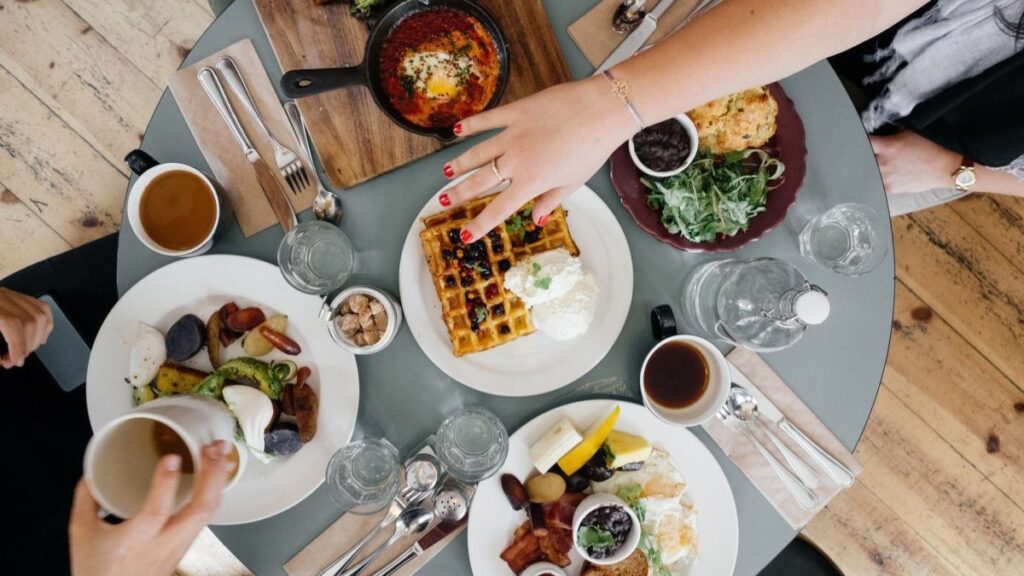The ambiance and presentation of a meal can significantly enhance the dining experience, making even simple food feel special. This article explores how restaurants use elements like lighting, music, and decor to influence mood and appetite. It will then provide techniques for applying these same principles at home to transform everyday mealtimes.
The Psychology of Ambiance
A restaurant’s ambiance is carefully designed to influence how you feel and behave from the moment you walk in. Every element is chosen to create a specific mood, encouraging you to relax, enjoy your food, and perhaps even spend a little more. Let’s break down the key components.
Lighting
Lighting is one of the most powerful tools for setting a mood. It can make a space feel intimate and cozy or bright and energetic.
- Soft, Warm Lighting: Dim, warm-toned lights create a sense of intimacy and relaxation. This is why fine-dining restaurants often use candles, dimmers, and shaded lamps. This type of lighting slows down the dining pace, encouraging guests to savor their food and conversation. It makes the environment feel like a retreat from the outside world.
- Bright, Cool Lighting: In contrast, fast-food chains use bright, often fluorescent, lighting. This high-energy environment encourages a faster turnover of customers. The bright lights keep people alert and moving, which is ideal for a quick meal but less so for a leisurely dinner.
Music
The soundtrack to your meal has a significant impact on your dining experience, affecting everything from your eating speed to your perception of taste.
- Volume and Tempo: Slow-tempo, low-volume music, such as classical or jazz, is associated with a more relaxed dining experience. Studies have shown that this type of music can lead to customers staying longer and spending more money. Conversely, fast-paced, loud music can cause people to eat more quickly, a tactic often used by establishments aiming for high customer turnover.
- Genre: The genre of music should match the restaurant’s theme and target audience. An Italian restaurant playing traditional Italian music reinforces its cultural identity, while a trendy, modern bistro might opt for indie pop or electronic music to create a vibrant, youthful atmosphere. The right music makes the experience feel more cohesive and immersive.
Decor and Layout
The physical environment—from the color of the walls to the arrangement of the tables—plays a crucial role in shaping your perception of a dining space.
- Color Palette: Colors have a profound psychological effect. Warm colors like red and orange are known to stimulate appetite, which is why they are popular in many restaurants. Cooler colors like blue and green can have a calming effect, often used in health-focused cafes or seaside establishments.
- Space and Comfort: The layout of a restaurant affects comfort and privacy. Cramped tables can make a space feel chaotic and rushed, while well-spaced tables offer a sense of exclusivity and calm. The quality of the furniture also matters. Comfortable chairs invite guests to linger, while hard, less comfortable seating might subtly encourage them to leave sooner. Even the quality of the tablecloths and napkins, often managed by restaurant linen services such as those in Lansing, contributes to the overall impression of quality and care.
The Art of Food Presentation
We eat with our eyes first. The way food is presented on the plate can influence our perception of its taste and quality before we even take a bite. Thoughtful plating is an art form that balances color, texture, and composition.
Plating Techniques
How food is arranged on the plate is a key element of presentation. Professional chefs use several techniques to make their dishes look as good as they taste.
- The Rule of Thirds: This classic composition principle from photography also applies to plating. Imagine your plate is divided into a 3×3 grid. Placing the main element of your dish off-center, at one of the intersecting points, creates a more dynamic and visually interesting arrangement than placing it directly in the middle.
- Height and Texture: Building height on the plate adds dimension and sophistication. This can be achieved by stacking ingredients or leaning them against one another. Varying textures—like pairing a smooth purée with a crispy element—also makes the dish more engaging.
- Negative Space: Don’t overcrowd the plate. Leaving empty space around the food helps to frame it, making the dish look more elegant and focused. A clean, uncluttered plate allows the key ingredients to shine.
Color Coordination
A vibrant, colorful plate is naturally more appealing. Chefs use color to make food look fresh and appetizing.
- Use a Variety of Colors: A monochromatic plate can look dull. Incorporate a range of colors using different vegetables, sauces, and garnishes. For example, a piece of grilled salmon can be brightened with green asparagus, a swirl of yellow lemon butter sauce, and a sprinkle of red paprika.
- Natural Colors: The most appealing colors are those that look natural. Avoid artificial food coloring and instead rely on the natural hues of fresh ingredients. Think of the deep red of beets, the bright orange of carrots, or the rich green of fresh herbs.
The Finishing Touch: Garnishing
Garnishes are the final flourish that completes a dish. A good garnish should be edible and complement the flavors of the meal.
- Herbs and Microgreens: A sprinkle of fresh, chopped herbs like parsley or chives adds a pop of color and a fresh flavor. Microgreens are a popular choice in modern restaurants for their delicate appearance and concentrated taste.
- Sauces and Drizzles: A creatively applied sauce can transform a plate. Use a squeeze bottle to create elegant swirls, dots, or lines. A drizzle of high-quality olive oil or balsamic glaze can also add visual appeal and a final layer of flavor.
- Edible Flowers: For a special touch, edible flowers like pansies or nasturtiums can add a beautiful and unexpected element to a dish, especially for salads and desserts.
Creating Ambiance at Home
You don’t need a team of designers to create a wonderful dining ambiance at home. With a few simple adjustments, you can make your everyday meals feel more special.
- Dim the Lights: If you don’t have a dimmer switch, use lamps or candles to create soft, warm lighting. Even a simple string of fairy lights can add a magical touch.
- Create a Playlist: Put together a playlist of your favorite relaxing music. Match the genre to the type of meal you’re having—perhaps some French café music for a bistro-style dinner or gentle classical for a more formal occasion.
- Set the Table: Take a few extra minutes to set the table properly. Use placemats, cloth napkins, and your best dishes, even for a weeknight meal. A simple centerpiece, like a small vase of flowers or a few candles, can make a big difference.
- Plate with Care: Apply the plating techniques discussed earlier. Use your largest plates to create negative space, add a fresh garnish, and think about how you can add color and height to your dishes.
Conclusion
Now that you know the basics of plating, it’s time to put these techniques into practice. Remember to have fun and be creative with your plating. With a little bit of effort, you can turn any meal into a stunning culinary experience.






